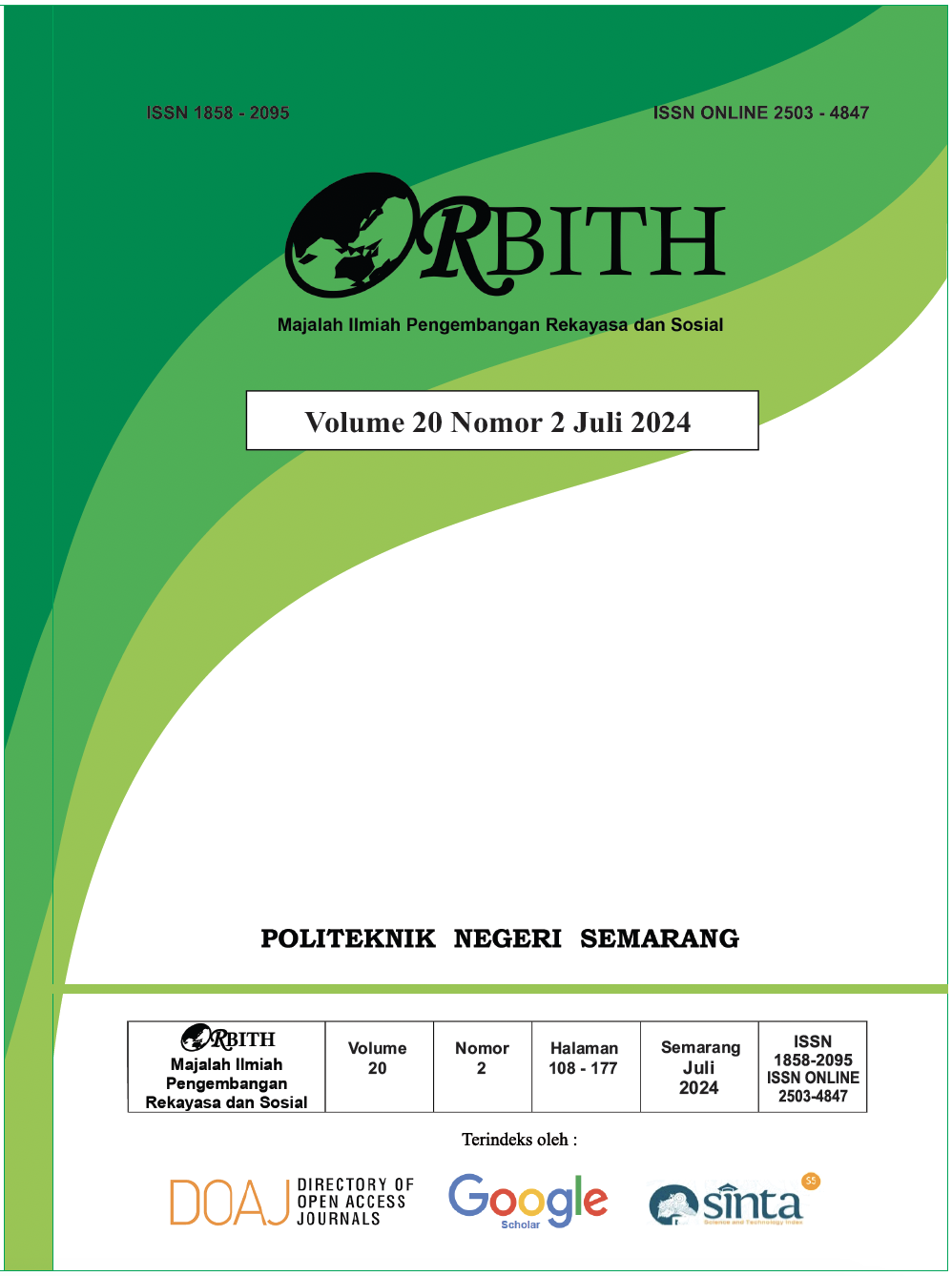PENGARUH ELECTRICITY SAVING BOX TERHADAP PENGGUNAAN ENERGI DAN TAGIHAN LISTRIK BULANAN PADA KELAS PELANGGAN TEGANGAN RENDAH
DOI:
https://doi.org/10.32497/orbith.v20i2.5776Abstract
Abstrak
Listrik merupakan kebutuhan pokok energi yang banyak digunakan sebagai penunjang kehidupan manusia. Segala peralatan dari berbagai bidang teknologi dan rumah tangga dalam pengoperasiannya membutuhkan energi listrik. Mayoritas masyarakat masih mengandalkan PLN sebagai sumber utama penyedia energi listrik. Rupiah tagihan listrik berbanding lurus dengan tarif dasar listrik dan jumlah energi listrik yang dikonsumsi dalam kWh. Variabel yang dapat diubah untuk menekan tagihan listrik adalah pada sisi konsumsi energi. Oleh karena itu berbagai upaya dilakukan dalam rangka melakukan penghematan listrik. Banyak alat-alat baru yang beredar di masyarakat dengan embel-embel dapat melakukan penghematan listrik salah satunya adalah electricity saving box. Pengaruh alat electricity saving box sebagai alat penghemat listrik perlu dikaji. Urgensitas dan kelayakan alat dapat diketahui melalui pengukuran dan pengujian langsung. Harapannya pelanggan PLN dapat melakukan perhitungan mandiri terkait efisiensi penggunaan energi listrik dan biaya investasi alat. Hasil pengujian menunjukkan penggunaan electricity saving box justru dapat meningkatkan konsumsi energi listrik beban rumah tangga sebesar 21%.
Abstract
Electricity is a basic energy need widely used to support human life. All equipment in various fields of technology and household operations requires electrical energy. The majority of the public still relies on PLN (State Electricity Company) as the main source of electricity supply. The electricity bill is directly proportional to the basic electricity rate and the amount of electrical energy consumed in kWh. The variable that can be altered to reduce the electricity bill is the energy consumption side. Therefore, various efforts are made to save electricity. Many new devices circulating in the community claim to save electricity, one of which is the electricity saving box. The impact of the electricity saving box as an energy-saving device needs to be studied. The urgency and feasibility of the device can be determined through direct measurement and testing. It is hoped that PLN customers can independently calculate the efficiency of electricity use and the investment cost of the device. The test results show that using an electricity saving box can increase household energy consumption by 21%.
References
A. Al-Subhi. 2022. “Energy Saving Device: Conceptual Review and Field Measurements.” In 2022 International Conference on Computing, Electronics & Communications Engineering (iCCECE), 65”“70. https://doi.org/10.1109/iCCECE55162.2022.9875099.
A. E. Emanuel. 1997. “True and False Energy-Saving Devices.” IEEE Transactions on Industry Applications 33 (6): 1439”“43. https://doi.org/10.1109/28.649953.
C. M. Lin and M. T. Chen. 2017. “Design and Implementation of a Smart Home Energy Saving System with Active Loading Feature Identification and Power Management.” In 2017 IEEE 3rd International Future Energy Electronics Conference and ECCE Asia (IFEEC 2017 - ECCE Asia), 739”“42. https://doi.org/10.1109/IFEEC.2017.7992131.
Chen, Wei-Han, Huai-En Mo, and Tun-Ping Teng. 2018. “Performance Improvement of a Split Air Conditioner by Using an Energy Saving Device.” Energy and Buildings 174 (September):380”“87. https://doi.org/10.1016/j.enbuild.2018.06.055.
Ekeh, J.C., S.T. Wara, and H.E Orovwode. 2007. “Management of Existing Capacity of Electric Power with Energy Saving Devices.” Advanced Materials Research 18”“19:117”“24. https://doi.org/10.4028/www.scientific.net/AMR.18-19.117.
Fathabadi, Hassan. 2014. “Ultra High Benefits System for Electric Energy Saving and Management of Lighting Energy in Buildings.” Energy Conversion and Management 80 (April):543”“49. https://doi.org/10.1016/j.enconman.2014.01.002.
Iannuzzi, Diego, Flavio Ciccarelli, and Davide Lauria. 2012. “Stationary Ultracapacitors Storage Device for Improving Energy Saving and Voltage Profile of Light Transportation Networks.” Transportation Research Part C: Emerging Technologies 21 (1): 321”“37. https://doi.org/10.1016/j.trc.2011.11.002.
J. -Y. Kim, J. -W. Choi, and K. Choi. 2011. “Design of Automatic Energy Saving-Monitor for Reducing the Waste of PC Electricity.” In 7th International Conference on Networked Computing, 28”“31.
Jamaah, Akhmad, Daeng Supriyadi Pasisarha, Aggie Brenda Vernandez, and Amir Subagyo. 2023. “PRESTASI PENGHEMATAN ENERGI LISTRIK DENGAN TINDAKAN HABITUS PADA RUMAH TINGGAL MAHASISWA TINGKAT TIGA TEKNIK LISTRIK POLINES.” Orbith: Majalah Ilmiah Pengembangan Rekayasa Dan Sosial 19 (1): 9”“15.
L. Yingli, C. Xueshen, Z. Haisen, Z. Deqing, L. Yu, and W. Yilong. 2011. “A Multifunction Energy-Saving Device With a Novel Power-Off Control Strategy for Beam Pumping Motors.” IEEE Transactions on Industry Applications 47 (4): 1605”“11. https://doi.org/10.1109/TIA.2011.2156370.
M. -T. Chen and C. -M. Lin. 2016. “Development of a Smart Home Energy Saving System Combining Multiple Smart Devices.” In 2016 IEEE International Conference on Consumer Electronics-Taiwan (ICCE-TW), 1”“2. https://doi.org/10.1109/ICCE-TW.2016.7521072.
R. Malhotra, E. McLeod, and T. Alzahawi. 2021. “Management and Maintenance of Electrical Equipment in Industrial Facilities: Procedures for Improving Safety While Saving Money.” IEEE Industry Applications Magazine 27 (1): 48”“54. https://doi.org/10.1109/MIAS.2020.3024486.
S. Shi, G. Wei, W. Bin, S. Wu, Z. Wei, Y. Jun, Y. Jiaquan, and L. Guihai. 2015. “Design and Development of Electrical Energy-Saving Diagnosis Calculator APP.” In 2015 Sixth International Conference on Intelligent Systems Design and Engineering Applications (ISDEA), 281”“87. https://doi.org/10.1109/ISDEA.2015.78.
Sadeghian, Omid, Arash Moradzadeh, Behnam Mohammadi-Ivatloo, Mehdi Abapour, Amjad Anvari-Moghaddam, Jeng Shiun Lim, and Fausto Pedro Garcia Marquez. 2021. “A Comprehensive Review on Energy Saving Options and Saving Potential in Low Voltage Electricity Distribution Networks: Building and Public Lighting.” Sustainable Cities and Society 72 (September):103064. https://doi.org/10.1016/j.scs.2021.103064.
Taufik, Taufik, A. Hernadi, R. Rudianto, and Makbul Anwari. 2007. “Performance Study of Power Factor Correction Circuits.” Electrical Engineering, January.
Downloads
Published
Issue
Section
License
Authors who publish with this journal agree to the following terms:Authors retain copyright and grant the journal right of first publication with the work simultaneously licensed under a Creative Commons Attribution License that allows others to share the work with an acknowledgement of the work's authorship and initial publication in this journal.
Authors are able to enter into separate, additional contractual arrangements for the non-exclusive distribution of the journal's published version of the work (e.g., post it to an institutional repository or publish it in a book), with an acknowledgement of its initial publication in this journal.
Authors are permitted and encouraged to post their work online (e.g., in institutional repositories or on their website) prior to and during the submission process, as it can lead to productive exchanges, as well as earlier and greater citation of published work (See The Effect of Open Access).






